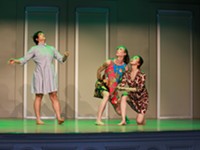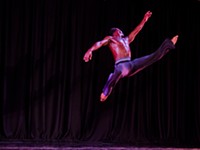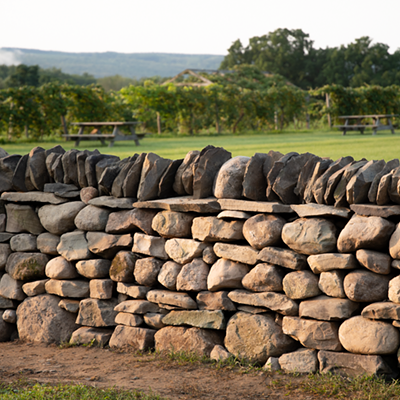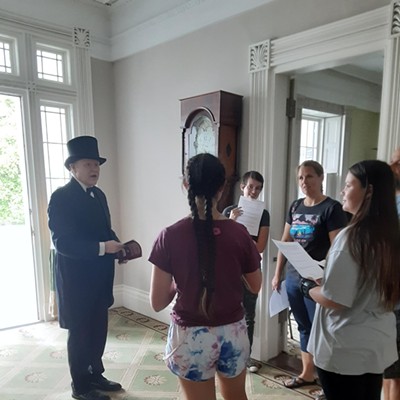[
{
"name": "500x250 Ad",
"insertPoint": "5",
"component": "15667920",
"parentWrapperClass": "",
"requiredCountToDisplay": "1"
}
]
Like countless other post-industrial cities suffering from ongoing decline - such as Detroit, Michigan, and Oakland, California - Rochester has a bit of an identity crisis. Meaning, the city is limping along economically, with seemingly very little vision for our current state, let alone our future, while our humiliating mountain of failed projects keeps rising (see: Fast Ferry, Renaissance Square, developing Midtown, etc.). Segregation along race and poverty lines is as sharply defined as the Inner Loop's boundaries, and a slowing of the mass exodus, so-called the "brain drain," is nowhere in sight. "Transitions-Rochester," a collaborative exhibit and series of events held at three local cultural institutions, explores how our city is dealing with its transitional period, and seeks to open up discussion about what future Rochester might be shifting toward. It remains to be seen if we will pull together to improve the quality of life for all Rochester residents, revitalize the city center, and invent a future for ourselves.
"Rochester's days as a company town are over, and urban sprawl and ineffective city planning have left it a disabled core surrounded by middle-class wealth," begins the provided statement from participating venue Visual Studies Workshop regarding the exhibit. "Transitions-Rochester" is collaborative in a few ways: between local and international artists, between arts institutions in the area, and possibly, between visionaries and movers and shakers inspired to effect some real and substantial change in this place.
The project, initiated by Dutch photographers Theo Baart and Cary Markerink, and Rochester-based curators Rick Hock of Visual Studies Workshop and Alison Nordstrom of George Eastman House, also includes support from Visual Studies Workshop, FOTODOK of The Netherlands, Rochester Contemporary Art Center, Eastman House, photographer Andrea Stultiens of the Netherlands, as well as the Rochester-based photographers Gregory Halpern and Oscar Palacio, sound artist Jason Bernagozzi, and graffiti mural artists the FUA Krew. The exhibitions kicked off August 5 and some aspects of the project continue through November 13. Much of the exhibition explores the role of Kodak and popular photography in the shaping of Rochester's self-image, and asks the question of how Rochester will choose to cope in the aftermath of Kodak's legacy.
The seeds for "Transitions-Rochester" were planted with a 2009 George Eastman House exhibition in collaboration a Dutch museum, says George Eastman House curator Alison Nordstrom. This exhibit, entitled "Nature as Artifice," was a show of contemporary Dutch landscape photographs by more than a dozen Dutch photographers based on the premise that there is no natural land left in Holland - because of a dearth of space, everything has been developed.
"Several of the photographers came here for the show, because it had a lot of site-specific installations in it," says Nordstrom. "Two of them - Cary Markerink and Theo Baart - fell in love with Rochester. They'd never seen anything like it. And it was so interesting walking around Rochester with them and listening to what caught their eye. What they loved was all those abandoned industrial buildings that we have, because in Holland, since there's no room, the moment a factory closes, the building gets repurposed for something else."
As Nordström spoke, I was struck with self-consciousness: what would such an efficient culture think of our baffling apathy over use of land, space, and ready-to-reuse structures?
Markerink and Baart also saw many similarities between Holland and our city, and as photographers who both work with urban planners, "one of their questions was: what is the best response, in a city that has been based on manufacturing, when the factories go away? And I think they were particularly interested in the fact that what we used to manufacture here was photographic," says Nordstrom.
With support from the Dutch government, Markerink and Baart initiated this project, which would be a study of Rochester from a foreign perspective, with the idea that eventually the artists will do a similar study in a former manufacturing city in Holland. The project grew to include work by a third Dutch photographer, Andrea Stultiens, as well as a number of Rochester-based artists, together adding to the story of what Rochester has been, what it is, and what it might yet become.
The first exhibit to open in the "Transitions-Rochester" project was Rochester Contemporary Art Center's "State of the City 2011: In the Loop," which was on display August 5 through September 25. The show focused in particular on the cumbersome, divisive Inner Loop, with beautiful paintings of the Loop and its surrounding areas by Jim Mott; photos that omitted the roadway from the landscape as well as an interactive re-envisioning of the space it occupies by Cary Markerink; layered graphics and information telling the history of our Loop and others presented by The Landmark Society of Western New York (in collaboration with designers and artists Eric Bridle, Lisa Feinstein, and Matté); a video, photo, and drawing installation by Rochester experimental artists Bartow+Metzgar with James Downer and Greg Stewart; and Ithaca artist Mark Edward Grimm's surreal surveillance-installation dealing with police activity and interaction over radio in and around the Inner Loop.
The exhibit at Visual Studies Workshop is accompanied by six books produced for this project, each including images and essays from each of the individual projects, packaged in a slim, Kodak-esque gold folio. An abbreviated version of most of these artists' works is also found at George Eastman House through November 6.
"'Transitions' was conceived as a way for artists to be included in discussions about the future of Rochester, says Visual Studies Workshop Director Tate Shaw. "We recognize that new artist support models no longer give time and money directly to artists expecting they will simply create culture independently. Now artists and designers are at the center of larger, community-wide efforts of city planning, economic and community development, and this is where VSW is taking its artist-support programs. I see 'Transitions' as a model for future interdisciplinary efforts supporting communities here in the city."
At VSW, Cary Markerink's "Inner Loop" includes images of people and downtown scenes, bits of debris, in color atop black and white scenes, and is complemented by an essay about his first morning in Rochester. The artist contemplates the Berlin Wall fragment on display in the Bausch & Lomb headquarters, entitled "Every Wall Falls Eventually," and wonders if a dismantled piece of the Inner Loop might one day join this mini exhibit, which he feels should be titled, "All Infrastructure Eventually Becomes Obsolete."
The 2.68-mile ring-road that "physically and mentally" divides downtown from the rest of the city has a presence "like a scar," says Markerink in his essay. The loop dead-ends streets like a "local variation of the Berlin Wall," he says, and simultaneously speaks volumes about our lack of integration skills with our structures as well as with our people.
Theo Baart's "Sound Horn" is full of images of an abandoned downtown with loads of empty lots, derelict buildings, and includes three of 20 total essays from individuals from various Rochester communities. One story features a former Kodak employee who, when laid off after nearly 25 years of employment, found himself working the same job at the same desk, the only difference being the new signature on his paycheck from the contracting company who hired him. Baart's work is a prelude to a larger publication about cities and regions that, "hit hard by the departure of the manufacturing industry, are looking for new sources of income," per the artist's statement.
By contrast, RIT professor Gregory Halpern's images could have been be taken anywhere. Where they show the broken-down detritus of the city, it's done mostly in minute detail - an eerily glowing shard of broken glass in the dark dirt, or a bit of plastic garbage left behind in a concrete corner. His images of people are lovely portraits: a child slightly turned away in the shadows, a man holding the camera's gaze and standing amid seemingly lush plant life. An immense tree with truncated limbs stands in an atmospheric field with the glow from nearby houselights, its unproductive remaining mass perhaps a subtle metaphor.
"I am personally drawn to Gregory Halpern's darkly poetic vision of Rochester and cities like it as imagined gardens of Eden that have cast us out," says VSW Director Tate Shaw. "The point is to show that Rochester is not a paradise, but a place worth rethinking."
Eastman House allotted the gallery space nearest its University Avenue entrance for its survey show of around 50 images from the individual photographic explorations of Rochester by Andrea Stultiens, Oscar Palacio, and Gregory Halpern, and the collaborative photos by Cary Markerink and Theo Baart. Many of the images are included in the Visual Studies Workshop exhibit as well.
Markerink and Baart worked independently but also collaborated under the title "Works on Paper," says Nordstrom. This is a project about parking lots, "which seemed so Rochester to Cary and Theo, because it's not nearly as common to have a car in Holland as in the United States. Everyone rides bicycles and takes public transportation, and if there are parking lots, they tend to be multi-storied because there's no room."
"The number of parking lots in Rochester really surprised them, and that's what they focused on," says Nordstrom. "You can just see their kind of wonder - here's all this space where you could build 30 apartment buildings, but we haven't." Perhaps it takes an outsider to properly discern the true waste of what is to many of us visual white noise. Picture after picture reveals a fascinated look at blacktop crisscrossed with parking-space quadrants and repaired tar, contrasted with amazing expanses of bright blue sky - available to the eye due to the uninterrupted flat spans of land - with towering, fluffy clouds.
The usage of space is also one of the foci of Colombian-born, Rochester-based Oscar Palacio, who also teaches at RIT. His project, "The Great Yellow Father" - a nickname for Kodak by employees - so-named for Kodak's bearing on this town, includes aerial shots of quadrants of Kodak Park taken in 2005 (shown in color) and again in 2009 (displayed in black and white). Where change is evident, it shows not development, but decline. Some areas where buildings once stood are now empty lots, and where parking lots were once filled to the brim with employees' vehicles, far fewer cars are parked there today.
Palacio is also "particularly interested in the idea of paternalism" says Nordstrom. Any company town has some element of the paternal, she says, "but because [Palacio] comes from a Latin-American culture, which is much more strongly paternalistic than ours, he was particularly interested in the way Kodak advertized its products in South America." Given access to the Eastman House Legacy Collection, which holds all of the advertizing Kodak ever did, Palacio researched ads generated by Kodak for the South American market, with an interest in imagery that dealt with the role of the father. As a result, part of Palacio's exhibit includes idyllic vintage photos of fathers photographing their families, or men photographic women, used in adverts for Colombia's "Cromos" magazine in the 1920's.
"This project explores the death of the 'father' and its urban implications for the city of Rochester," per the artists' statement for his works at VSW and Eastman House. "The Kodak Corporation, colloquially known by employees as 'The Great Yellow Father' and 'Daddy Kodak,' has visibly declined."
Also hailing from Holland, photographer Andrea Stultiens sought to connect with people in Rochester by interviewing and photographing retired Kodak workers, photographing people at Ontario Beach Park and Seabreeze, and photographing people photographing others at those locations, emphasizing what an effectively democratized pastime photography remains.
Stultiens' VSW installation, "Reasons to Smile," includes these images as well as Rochester and Kodak ephemera in the form of booklets of images pinned to the wall. "Hope" is a booklet of the highest-rated photos of Mt. Hope Cemetery on image-hosting website Flickr. Images include dogs playing in leaves and flowers, glowing twilight, and lovely architecture. Another, entitled "For Sale," holds photographs of Kodak items, including old cameras, film, and other paraphernalia, taken by Andrew Ghend, for eBay sales. "A Good Night" is full of photographs by Allen Keppen (of ihadagoodnight.com) of young people out drinking being...young people out drinking.
Also at Visual Studies, "Inner Workings," a collaboration between VSW grad students Julia Muniz, Jason Bernagozzi, and Dan Varenka, as well as Rochester's premier graffiti writers, FUA Krew, examines Rochester's relationship, or lack thereof, with the north side of the city. The Puerto Rican and African-American communities who live and work on and around North Clinton Avenue need a "change in consciousness and a sense of ownership," says Muniz. The installation and accompanying book include interviews with and portraits of residents, images of of FUA Krew at work on their striking murals, at the annual BBOY BBQ, and in the abandoned subway.
In a room opposite the main Siskind Gallery space at VSW, Jason Bernagozzi's "The City is Breathing" is a sound sculpture made of a chain of speakers that play noises recorded under the streets in steam vaults, sewers, drainage systems, and abandoned subway tunnels. The work explores the body system of the city that is "powered, fueled, and even destroyed by the beings that shape and inhabit its borders," per the provided statement. The artist compares electrical lines to a nervous system, and water pipes to veins. The recorded and played-back cacophony is a symphony of hisses, muffled voices, sounds like glass shattering and repetitive clanks, revealing an eerie, mysterious underworld that leaves the viewer considering the city as a living organism, worthy of attention and care.
FUA Krew's spray-paint installation is a freestyle image by group members Oz, Cruk, and Efie that takes up the entire center wall structure of the VSW's Siskind Gallery, depicting on one side a bygone era of happy shoppers in Midtown Plaza. The flip side of the wall is a dystopian version of the same scene, complete with a wrecking ball, a man holding a gun, and a derelict-looking group of people. Nordstrom felt that it was crucial to include art by FUA Krew in this endeavor. They're "probably the most important artists in Rochester," she says, "they're so widely recognized in Europe and Asia," but not as much here.
In a side space, Dan Varenka's video "After the Riots" includes a bit of a history lesson, told at ground level through newspaper headlines, images, and voiceover by 7th Ward residents and community-housing activists, about the discrimination leading up to the 1964 race riots, the aftermath, how none of the promises made to Rochester's poorest residents have been kept, and how relations between the police and African Americans aren't much better now. "People that didn't grow up in Rochester, in the city, don't have the same concerns" as outsiders who commute for work, says Range of FUA Krew.
It's easy to share the same city and the same dilemmas as the people in Rochester, says Nordstrom, but to only really get to know the people who are exactly like you. But exhibitions such as "Transitions-Rochester" have the potential to bring people together over crucial issues, she says. "Cultural institutions can start the conversations - for one thing, it makes us a place to have the conversation, and you can't have too many of those."
"I think the exhibit and publications address the need for more shared public experiences in Rochester," says VSW's Shaw. "When you look at the bleak landscape around the Kodak Park-area bus stop photographed by Oscar Palacio, or the dark and divisive chain-linked borders of the Inner Loop and the empty lots as pictured by Cary Markerink and Theo Baart respectively, the environment is showing us that our use of space needs reconsidering."
"Pending funding, it is our hope that the American photographers who have been part of this project will go to Holland and will work in one of the cities that used to manufacture electronic equipment [...] and compare how that country and that culture is dealing with [living] in a formerly industrial community," says Nordstrom. "We are certainly not alone in facing these challenges."
Visual Studies Workshop will hold an open-house event on Thursday, October 13, 6-10 p.m. at 31 Prince Street, at which you can view the exhibit, witness a live painting demo by FUA Krew, and provide your own commentary in the custom gallery video booth. Displays from the Workshop's visual resources will be exhibited throughout the space, and myriad images from VSW's vast collections of lantern slides, news story and street photography, rare albums and books, will be available for viewing. Screenings and live events in the auditorium will also take place throughout the evening. For more information check the "Transitions-Rochester" blog at transitionsrochester.wordpress.com.
"Transitions-Rochester"
Through November 13
Visual Studies Workshop, Siskind Gallery, 31 Prince St.
Thursday 5-8 p.m., Saturday-Sunday noon-5 p.m. | Free
442-8676, vsw.org, transitionsrochester.wordpress.com
Through November 6
George Eastman House, 900 East Ave.
Tuesday-Saturday 10 a.m.-5 p.m., Thursday until 8 p.m., Sun 1-5 p.m. | $5-$12
271-3361, eastmanhouse.org
Latest in Art
More by Rebecca Rafferty
-

Beyond folklore
Apr 4, 2024 -

Partnership perks: Public Provisions @ Flour City Bread
Feb 24, 2024 -

Raison d’Art
Feb 19, 2024 - More »





